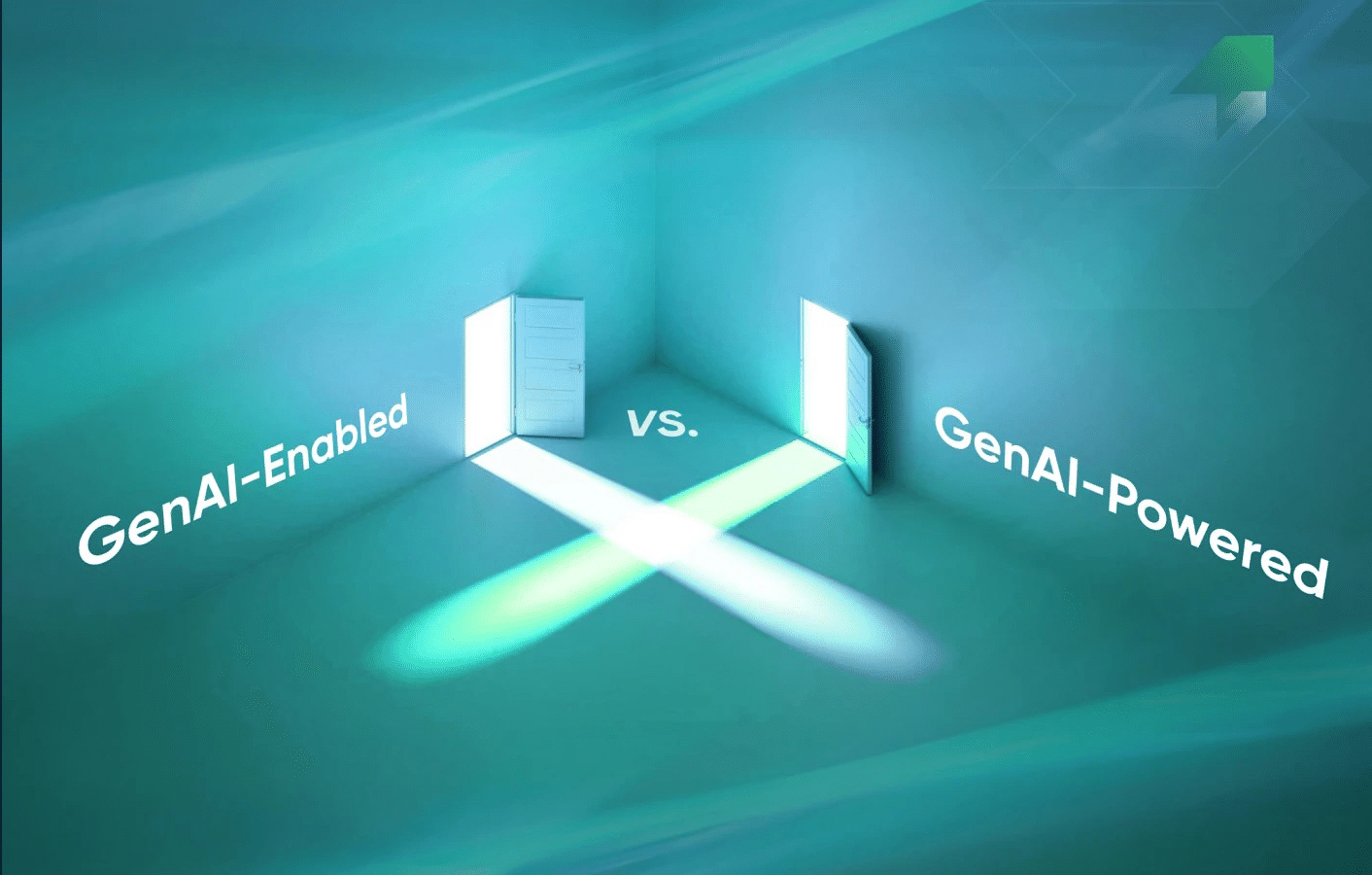
The Fine Print Behind “AI Adoption”
Enterprises today claim to have “AI inside.”
But that label hides two very different realities.
One group adds generative AI features to existing systems chatbots, summarizers, or assistants woven into familiar dashboards. Another rebuilds their platforms so that intelligence is the core operating layer every workflow, decision, and output runs through AI.
That’s the real divide between being GenAI-enabled and GenAI-powered.
And according to McKinsey and IDC, this distinction already defines who sees measurable ROI and who’s still stuck in pilots. The difference isn’t cosmetic; it determines whether AI becomes a helper or the backbone of how an organization operates.
What Each Path Really Means
GenAI-enabled platforms take what’s already working e.g. CRMs, ERPs, HR suites and add generative features through APIs or copilots. Salesforce embedding Einstein GPT or SAP integrating Joule into S/4HANA are classic examples. These enhancements improve convenience and user experience but sit on legacy foundations. They’re efficient to implement and relatively low risk, but the intelligence layer remains peripheral, it enhances workflows without reshaping them.
GenAI-powered platforms, on the other hand, are built around AI from day one.
They use large language or domain-tuned models as the workflow engine itself. Systems built on AI-native architectures, such as Google Vertex AI, Microsoft Azure OpenAI, or AWS Bedrock, don’t just use AI, they run on it. Here, every layer from data pipelines to business logic is designed for intelligence, context retention, and decision autonomy.
Enabled means enhanced.
Powered means driven.
And the difference becomes painfully visible when you try to scale.
Why the Difference Matters
Between 2024 and 2025, 71% of enterprises used GenAI in at least one business function (McKinsey). Yet less than 15% of plug-in integrations ever reached full production maturity, and most delivered only anecdotal ROI. In contrast, AI-native systems reported 2–5× higher returns and 30% faster workflow execution (reWorked 2025). This is because surface-level enhancements often improve efficiency but not adaptability; the system doesn’t learn, evolve, or interconnect across functions.
When GenAI becomes the decision layer not just a feature it drives compound gains.
It reduces time-to-market, improves data reuse across business units, and makes processes self-optimizing. The difference shows up in how fast insights turn into action and how reliably AI-driven recommendations translate into measurable business results.
Enabled tools make systems smarter. Powered platforms make businesses faster. In the long run, speed and adaptability are what define competitive advantage.
Architecture: The Invisible Divider
Under the hood, this isn’t just a philosophical choice, it’s architectural.
How AI integrates into your system determines what it can actually do, how far it can scale, and how securely it can operate.
| Dimension | API-Based (Enabled) | AI-Native (Powered) |
| Scalability | Flexible but constrained by API limits and vendor throttles | Cloud-native scale with microservices and load balancing |
| Data Flow | Cross-boundary, fragmented, slower auditing | In-memory, event-driven, governed pipelines |
| Context | Stateless, limited memory | Persistent agent context and domain alignment |
| Governance | External policies, siloed logs | Native data lineage and explainability |
API integrations bolt AI on top of data.
AI-native platforms build AI into data flow. That small design difference shapes every downstream capability from response accuracy to auditability.
An API-based model might be enough for pilots or isolated functions, but it starts showing cracks under enterprise-scale workloads. Native architectures, however, grow with complexity; they’re built to handle context, concurrency, and control at the same time.
Impact on People, Not Just Platforms
Generative AI isn’t only changing systems, it’s changing work itself.
A 2025 study by the U.S. Federal Reserve Bank of St. Louis found that AI users save an average of 5.4% of their weekly hours, roughly two hours a week per employee.
In customer support, AI assistance boosted productivity by 15% on average and helped new hires reach expert-level performance 30% faster (QJE 2025). These gains compound across teams, translating to faster project delivery, fewer escalations, and improved service quality.
Generative AI narrows skill gaps and shifts job design from manual execution to strategic supervision. It helps less experienced employees perform at the level of seasoned experts while freeing experts to focus on higher-order work.
But this payoff scales only when AI is deeply embedded into workflows, not when it’s an external plugin. Otherwise, employees end up switching between tools rather than collaborating with them, and productivity becomes fragmented instead of amplified.
ROI Is a Function of Depth
McKinsey’s 2025 survey found that 86% of production GenAI deployments report annual revenue growth, averaging 6% or more. However, 80% of enterprises still see no EBIT impact from pilots because the AI layer sits too far from the core. When AI runs parallel to business processes, the effect is incremental; when it runs within them, the effect is exponential.
IDC forecasts that GenAI and automation will drive $1 trillion in global productivity gains by 2026, mostly among enterprises that move beyond API-based adoption. Financial services firms that embedded GenAI into decision systems saw returns up to 4.2× their investment (AmplifAI 2025). This shows that success isn’t just about deploying AI it’s about where you place it within your architecture.
So ROI follows depth. You can’t measure AI impact through usage metrics alone; you measure it through process transformation, cost savings, and time-to-decision improvements.
For leadership, the key question becomes: are we adding AI to workflows, or are we letting AI drive them?
Case in Point: What Enterprises Learned
GenAI-enabled successes like Shopify with GitHub Copilot or HP with Dynamics 365 saw 15–35% productivity gains in coding, customer support, and sales operations.
These tools worked within existing systems, accelerating tasks but not redesigning them.
They prove that GenAI-enabled models are ideal for incremental adoption, early wins, and user confidence.
GenAI-powered platforms built on ecosystems like Google Vertex AI, Microsoft Azure OpenAI, or AWS Bedrock have enabled global enterprises to achieve 10–50% productivity gains and up to 30% cost savings. Here, AI wasn’t a plug-in; it was the system’s brain. Every decision, from inventory management to customer service, ran through context-aware agents that learned continuously. This level of orchestration drives consistency, scalability, and measurable ROI, all while enabling adaptive, multi-agent collaboration across teams.
The pattern is clear: Enabled tools speed up tasks. Powered platforms reshape entire business models. And that’s the level of transformation enterprises can’t afford to ignore anymore.
Looking Ahead: The Shift to GenAI-Powered Enterprises
Analyst forecasts point to a decisive shift. Gartner projects that over 80% of AI infrastructure spend will soon support GenAI-powered inference workloads, and that by 2030, 60% of Fortune 2000 companies will re-architect their platforms around AI-native operations.
By then, a third of enterprise software will feature autonomous, agent-driven capabilities across supply chain, finance, and customer service.
This transition is not just about technology; it’s about strategy. As inference costs fall and agentic architectures mature, the competitive gap between “AI-assisted” and “AI-architected” will widen dramatically. Companies that treat GenAI as a core infrastructure layer will innovate faster, manage complexity better, and achieve measurable resilience in volatile markets.
In simple terms, enterprises will either be AI-capable or AI-centric.
Only the latter will stay competitive.
How to Choose Your Path
Before committing to either approach, leadership teams should ask:
1) What’s the problem we want AI to solve efficiency or reinvention?
If it’s efficiency, start enabled. If it’s reinvention, go powered. Think of it as the difference between adding a turbocharger and designing a new engine altogether.
2) Is our data ecosystem ready for contextual intelligence?
Without unified, high-quality data, AI will always hit a ceiling. A fragmented data foundation turns even the most advanced models into underperforming assistants.
3) Do we have governance frameworks for AI decisioning?
Agentic systems need transparency, version control, and auditability built in. Without this, scaling AI introduces risks faster than it creates value.
4) Are we measuring output or business impact?
Output metrics show usage, not value. Business impact, such as time saved, costs reduced, or outcomes improved, is what proves the AI model’s real worth.
The best approach is often hybrid: start with small, GenAI-enabled use cases, prove measurable ROI, and evolve toward powered systems as data maturity and AI literacy grow.
This phased model reduces risk while keeping the organization’s transformation continuous and controllable.
At Amazatic, we see GenAI not as a feature race but a foundation shift. We help businesses move from enabled to powered through systems designed around measurable intelligence, human collaboration, and decision-ready data. Our teams build with the goal of making GenAI useful, verifiable, and operationally aligned from day one.
We turn experiments into evidence using benchmarks, baselines, and ROI dashboards that make GenAI performance tangible. Every deployment is tracked, every outcome measured, and every insight built into the next iteration. Because success isn’t about having AI, it’s about owning the outcomes it creates.
If your enterprise is still experimenting with GenAI features, it’s time to rethink what being “AI-driven” really means. Start by connecting your data, aligning your workflows, and building systems that can think with you, not just for you.
See how Amazatic helps enterprises build GenAI-powered platforms that deliver real business results: amazatic.com/genai

